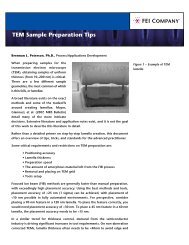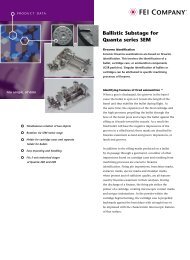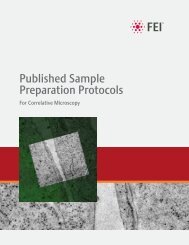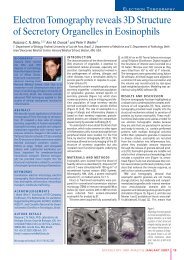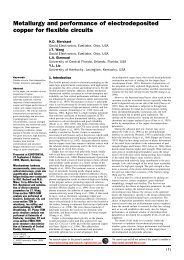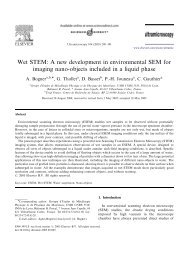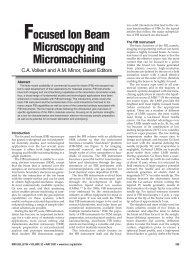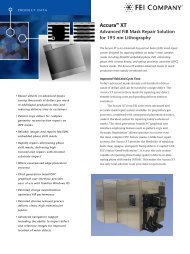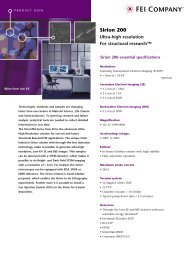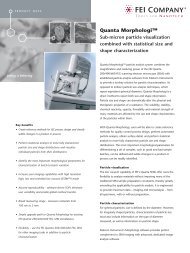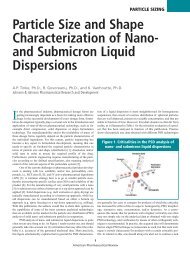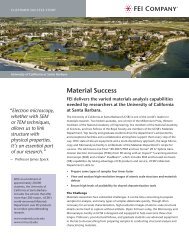Focused ion beam technology, capabilities and ... - FEI Company
Focused ion beam technology, capabilities and ... - FEI Company
Focused ion beam technology, capabilities and ... - FEI Company
You also want an ePaper? Increase the reach of your titles
YUMPU automatically turns print PDFs into web optimized ePapers that Google loves.
10<br />
Deposit<strong>ion</strong><br />
As FIB <strong>technology</strong> is frequently used for milling an<br />
addit<strong>ion</strong>al technique can convert the <strong>ion</strong> <strong>beam</strong> system<br />
into a deposit<strong>ion</strong> system allowing the addit<strong>ion</strong> of material<br />
instead of removing material. This is realized by<br />
adding a so-called gas delivery system, that locally<br />
supplies a chemical compound close to the surface<br />
impact point. The chemical gas compound often<br />
consists of a organic-metallic molecule such as methyl<br />
cyclo pentadienyl Pt (IV) tri methyl. When this compound<br />
is exposed to the <strong>ion</strong> <strong>beam</strong> it will decompose<br />
locally <strong>and</strong> deposit Pt onto the surface. In general the<br />
cracking of the molecule is not 100% so there are<br />
always some addit<strong>ion</strong>al matrix molecules such as organic<br />
residues that are also deposited. The purity of the<br />
deposit is therefore generally lower compared to, for<br />
example, CVD deposits. The main advantage in comparison<br />
to CVD or PVD is the highly local deposit<strong>ion</strong>,<br />
<strong>and</strong> the capability to create different heights of the<br />
deposit in one exposure. In addit<strong>ion</strong> the direct deposit<strong>ion</strong><br />
capability is flexible <strong>and</strong> does not require complex<br />
mask structures.<br />
Molecules are absorbed on the irradiated area, <strong>and</strong> by<br />
using the patterning capability of the system three<br />
dimens<strong>ion</strong>al structures can be grown at selected posit<strong>ion</strong>s,<br />
with full control of size, posit<strong>ion</strong> <strong>and</strong> height.<br />
So this capability is a very welcome addendum to the<br />
FIB’s milling power. The material deposited depends on<br />
the gas chemistry used <strong>and</strong> various opt<strong>ion</strong>s are possible.<br />
Readily available gas chemistry allows the deposit<strong>ion</strong> of<br />
Pt, W, SiO2, C.<br />
Figure 17: Light microscope image of the sample deposited ex-situ<br />
on a TEM grid. Ex-situ foil extract<strong>ion</strong> using electro-static probes<br />
works even for materials with low structural integrity.<br />
Important characteristics for the deposit<strong>ion</strong>s are the<br />
minimum size (typically around 50 nm), the purity of<br />
the material, <strong>and</strong> its conductivity which is usually lower<br />
than the pure metal.<br />
Creat<strong>ion</strong> of TEM lamella<br />
An important capability, derived from the system’s<br />
milling capacity, is the creat<strong>ion</strong> of thin lamella that are<br />
transparent to an electron <strong>beam</strong> <strong>and</strong> hence can serve as<br />
a TEM sample. As the posit<strong>ion</strong> of the <strong>ion</strong> <strong>beam</strong> can be<br />
controlled to a high degree, the TEM lamella can be<br />
created at any locat<strong>ion</strong> that is of interest to the user.<br />
<strong>Focused</strong> <strong>ion</strong> <strong>beam</strong> machining for the creat<strong>ion</strong> of TEM<br />
samples is now firmly established as the most versatile<br />
<strong>and</strong> accurate method currently available. There are<br />
several ways to extract the FIB machined foil from the<br />
bulk sample without having to use mechanical preparat<strong>ion</strong><br />
at all, so for the first time it is not necessary to<br />
sacrifice the sample when performing TEM analysis<br />
with the highest accuracy.<br />
Site specific<br />
The fact that the locat<strong>ion</strong> of the foil site can be defined<br />
inside the FIB makes this the only true site-specific<br />
technique available. The momentary feed-back of what<br />
<strong>and</strong> where FIB milling takes place is essential to<br />
generate the best samples from the reg<strong>ion</strong> of interest.<br />
Lateral placement of foils is quite simple, <strong>and</strong> the aimed<br />
thickness is in the range of 100 nm <strong>and</strong> can be controlled<br />
to a high degree.<br />
Material independent<br />
As the <strong>ion</strong> <strong>beam</strong> removes atoms from the sample in an<br />
atomic collis<strong>ion</strong> process rather than with a mechanical<br />
bulk cut or mechanical polish, the amount of <strong>ion</strong>s<br />
needed to remove different materials with varying hardness<br />
is not related to the structure or the composit<strong>ion</strong><br />
of the sample. This means that milling any material or<br />
a combinat<strong>ion</strong> of materials is as straightforward as a<br />
simple single crystal sample for <strong>ion</strong> <strong>beam</strong> machining.<br />
Even voided, brittle or soft/hard combinat<strong>ion</strong>s of materials<br />
are easy for the FIB process. Many TEM samples<br />
that were difficult or impossible to make until now (soft<br />
polymer coating on metal, hard metal on soft metal)<br />
are now easy to make using FIB <strong>technology</strong>.



